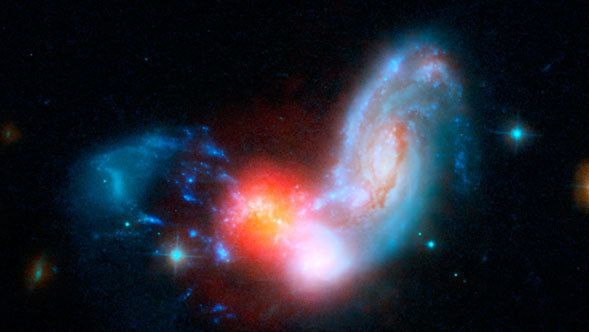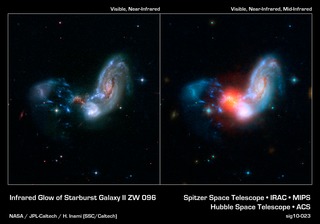
News Release • November 18th, 2010 • feature10-19 •
By Adam Hadhazy
Astronomers using NASA's Spitzer Space Telescope have found a stunning burst of star formation that beams out as much infrared light as an entire galaxy. The collision of two spiral galaxies has triggered this explosion, which is cloaked by dust that renders its stars nearly invisible in other wavelengths of light.
The starburst newly revealed by Spitzer stands as the most luminous ever seen taking place away from the centers, or nuclei, of merging parent galaxies. It blazes ten times brighter than the nearby Universe's previous most famous "off-nuclear starburst" that gleams in another galactic smashup known as the Antennae Galaxy.
The new findings show that galaxy mergers can pack a real star-making wallop far from the respective galactic centers, where star-forming dust and gases typically pool.
"This discovery proves that merging galaxies can generate powerful starbursts outside of the centers of the parent galaxies," says Hanae Inami, first author of a paper detailing the results in the July issue of The Astronomical Journal. Inami is a graduate student at The Graduate University for Advanced Studies in Japan and the Spitzer Science Center at the California Institute of Technology. She adds: "The infrared light emission of the starburst dominates its host galaxy and rivals that of the most luminous galaxies we see that are relatively close to our home, the Milky Way."
"No matter how you slice it, this starburst is one of the most luminous objects in the local Universe," agrees Lee Armus, second author of the paper and a senior research astronomer also at the Spitzer Science Center.
A dazzling galactic dust-up
Inami, Armus and their colleagues spotted the buried starburst with Spitzer in the interacting galaxies known as II Zw 096. This galactic train wreck - located around 500 million light years away in the constellation Delphinus (the Dolphin) - will continue to unfold for a few hundred million years. Gravitational forces have already dissolved the once-pinwheel shape of one of II Zw 096's pair of merging galaxies.
The ultra-bright starburst region spans 700 light-years or so - just a tiny portion of II Zw 096, which streams across some 50,000 to 60,000 light-years - yet it blasts out 80 percent of the infrared light from this galactic tumult. Based on Spitzer data, researchers estimate the starburst is cranking out stars at the breakneck pace of around 100 solar masses, or masses of our Sun, per year.
The prodigious energy output of this starburst in a decentralized location as revealed in the infrared has surprised the Spitzer researchers. The new observations go to show how the notion of a cosmic object's nature can change tremendously when viewed at different wavelengths of light. In this way, the shapes and dynamics of distant, harder-to-study galactic mergers could turn out to be a good deal more complex than current observations over a narrow range of wavelengths imply.
"Most of the far-infrared emission in II Zw 096, and hence most of the power, is coming from a region that is not associated with the centers of the merging galaxies," Inami explains. "This suggests that the appearances and interactions of distant, early galaxies during epochs when mergers were much more common than today in the Universe might be more complicated than we think."
A fleeting, perhaps prophetic vista?
In galaxy mergers, individual stars rarely slam into one another because of the vast distances separating them; even in the comparatively crowded central hubs of spiral galaxies, trillions of kilometers still often yawn between the stars.
But giant, diffuse clouds of gas and dust in galaxies do crash together - passing through each other somewhat like ocean waves - and in turn spur the gravitational collapse of dense pockets of matter into new stars. These young, hot stars shine intensely in the energetic ultraviolet part of the spectrum. In the case of II Zw 096, however, a thick shroud of gas and dust still surrounds this stellar brood. The blanket of material absorbs the stars' light and re-radiates it in the lower-energy, infrared wavelengths that gleam clear through the dust to Spitzer's camera.
Astronomers were lucky to capture this transient phase in the evolution of the starburst and of the daughter galaxy that will eventually coalesce out of the collision. "Spitzer has allowed us to see the fireworks before all the gas and dust has cleared away, giving us a preview of the exciting new galaxy being built under the blanket," Inami says.
Merging galaxies such as II Zw 096 also offer a sneak peek at the fate of our Milky Way in some 4.5 billion years when it is expected to plow into its nearest large galactic neighbor, the Andromeda Galaxy. Off-nuclear starbursts such as that in II Zw 096 and the Antennae Galaxy could occur in the vicinity of our Solar System, perhaps, which is located about two-thirds of the way out from the Milky Way's glowing, bulging center.
"This kind of dramatic thing happening in II Zw 096 could happen to the Milky Way and Andromeda when they meet in the far future," says Inami.





